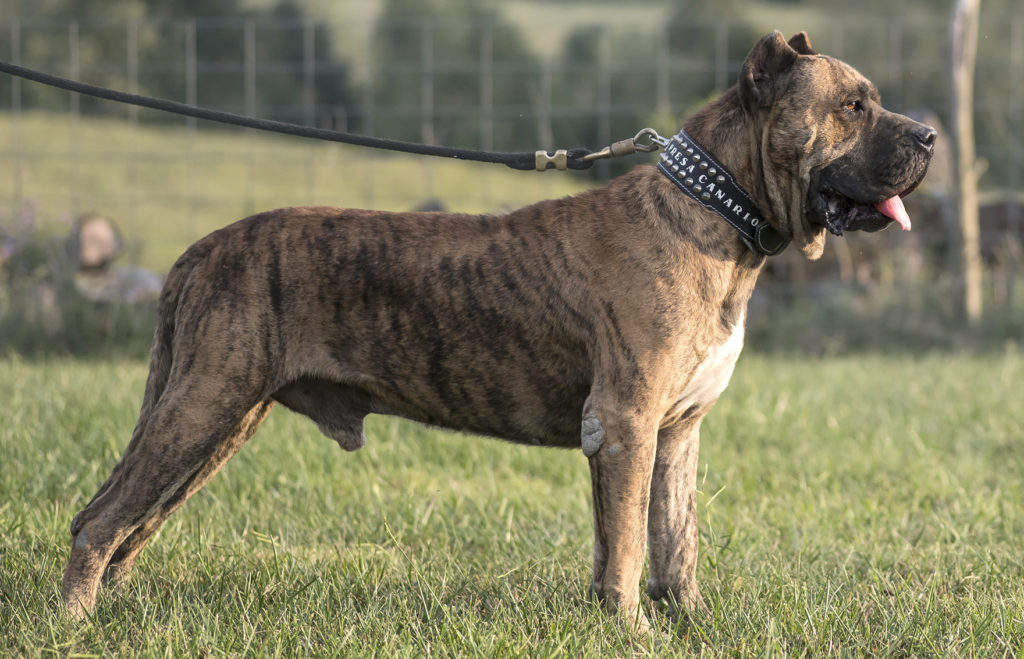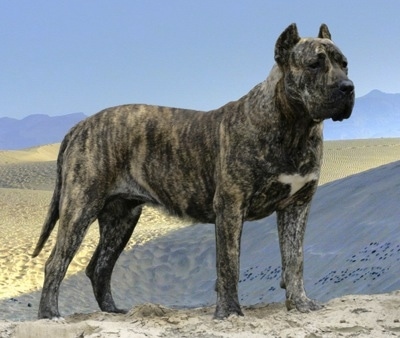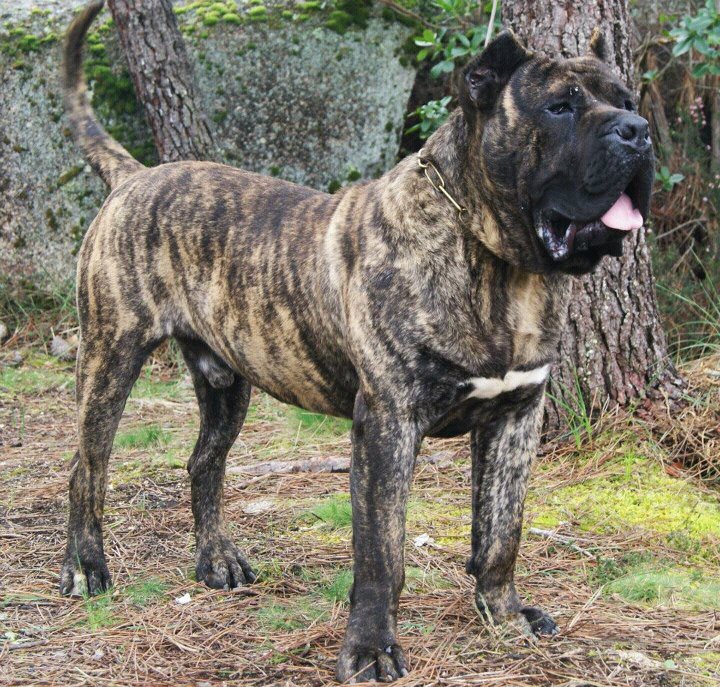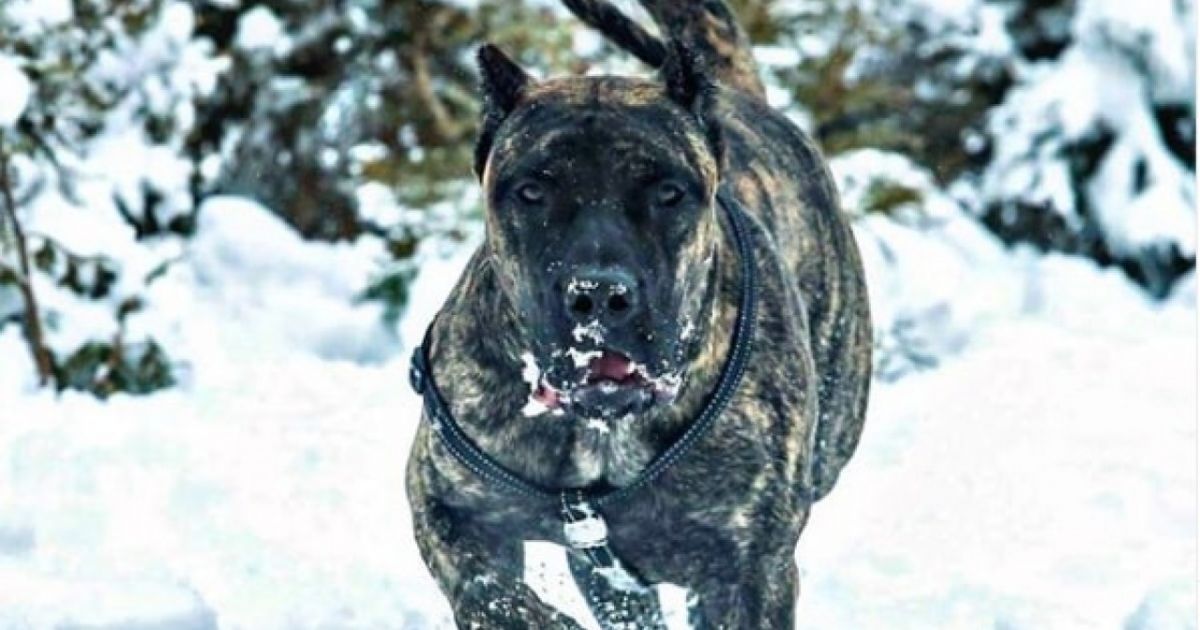Other Names: Canary Mastiff, Canary Catch Dog, Canarian Dogo, Presa Canario, Dogo Canario.
The Perro de Presa Canario, also known as the Canary Mastiff, is a rare large Molosser-type dog breed originally bred for working livestock. The name of the breed is Spanish, means “Canarian catch dog”, and is often shortened to “Presa Canario” or simply “Presa”. The breed is sometimes also called Dogo Canario, meaning “Canarian Molosser”. It is the animal symbol of the island of Gran Canaria.
Appearance

The Perro de Presa Canario or “Canary Dog” is a large-size dog with a thick and muscular body. The head is the broad, massive, square, and powerful brachycephalic shape. Proper head and good expression are part of the breed standard and are manifest in the best breed specimens. The ears are normally cropped, both to create a more formidable expression and to prevent damage while working with cattle. If cropped, the ears stand erect. In countries where ear-cropping is banned, the ears are close-fitting to the head; they hang down and should be pendant or “rose” shaped. The upper lip is pendulous, although not excessively. Seen from the front, the upper and lower lips come together to form an inverted V. The flews are slightly divergent. The inside of the lips is a dark colour.
Males have a standard desirable height range of 24 to 26 inches (61 to 66 cm) at the withers, with minimum weight at maturity of 100 pounds (45 kg) and a maximum weight of 155 pounds (70 kg). Females have a standard desirable height between 22.5 to 24.5 inches (57 to 62 cm) at the withers, with minimum weight at maturity of 88 pounds (40 kg) and a maximum weight of 60 kilograms (130 lb).
The breed is also characterized by a sloping topline (with the rear being slightly higher than the shoulders). Another characteristic of the breed is the shape of the paws (cat foot) and the catlike movement of the animal. The body is mesomorphic, that is, slightly longer than the dog is tall, contributing to the feline movement
History

The historian Agustín Millares Torres, in his “General History of the Canary Islands”, said that the derivation of large dogs in these islands was [incomplete]. According to his research, these dogs took part in the myths, funeral customs and even gastronomy of the natives (Guanches) of the islands. Demons appeared to these people as big fleecy dogs, known as “Tibicenas” in Gran Canaria and “Irnene” on the island of La Palma. In the funerary cults, the dogs appear mummified beside their owners (as guides to the afterlife). The dogs were also consumed in small amounts, as has been proven in archaeological discoveries.
In the aftermath of conquest, the presence of these dogs of molosser morphology on the islands is well documented, especially in the cedularios of the councils of Fuerteventura and Tenerife. The first quote after conquest dates from 1501, which allowed the puerqueros (pig farmers) to have “one of the larges.” In many periods, these dogs were used to kill the wild dogs that attacked cattle. Success was credited by the presentation of the skins of the heads. In other periods, many of these dogs were ordered to be killed for the damage they did to cattle. At one point, residents were given the opportunity to kill loose and wild dogs without punishment. In other occasions, the dogs were ordered to be bound. And still other times, due to the damage caused by these dogs, their possession was banned for anyone who was not a farmer or a hunter. All this occurred between the 16th and 18th centuries.
In addition to the traditional role of cattle dog, the Perros de Presa Canario has been used for dogfighting. Until the 1950s it remained a common practice in all of the islands. There exists ample testimony from former fans. The owners agreed on whether the fight had to be witnessed in silence or if they could incite the animals. No spectator could touch or bother the dogs in combat. The most widespread method was to place the animals within a circle marked on the ground, face to face. The fight began when the collars were removed. These were not organized public events. Instead, they emerged sporadically at the challenge of the owners. However, practically the whole neighbourhood participated in the show once it became aware of the fight. The fights were banned in the mid-1940s but lasted for another decade. From that moment, due to tightening by the Francoist authority for the eradication of dogfighting, the Perro de Presa Canario was relegated to counted breeders that kept the breed alive and prevented its total disappearance.
Name and standard

The Perro de Presa Canario has a legislative basis in Spain in the form of recognition by a Real Decreto (Royal Decree) of the Ministro de Agricultura, Pesca y Alimentación (Minister of Agriculture Fishing and Nutrition), which was published in the Official Gazette of the Spanish Government (BOE – Boletin Oficial del Estado). The original Real Decreto 558/2001 can be read on the site of the Spanish Government Gazette. In the decree, the breed is referred to as “Presa Canario”. A breed standard is attached in the Royal Decree and it includes having a black coat and specifies a maximum weight.
Any other name or standard is not recognized by Spanish law.
In Spain, there are two main organizations which are legally recognized by the Minister of Agriculture, Fishing and Nutrition (according to the requirements set by the Real Decreto 558/2001): the RSCE and the FCE. The term “legally recognized” means that these organizations have the power to inscribe the litters into the official Book of Origins of Spain (LOE – Libro de Orígenes Español).
